 Thank you for visiting HOJO website. If you have any enquiry, please feel free to get in touch with us at
Thank you for visiting HOJO website. If you have any enquiry, please feel free to get in touch with us at
▼ Akira Hojo
▼ Hojo Newsletter
▼ HOJO FACEBOOK





HOME > Oolong Tea > Vintage 30 years Oolong
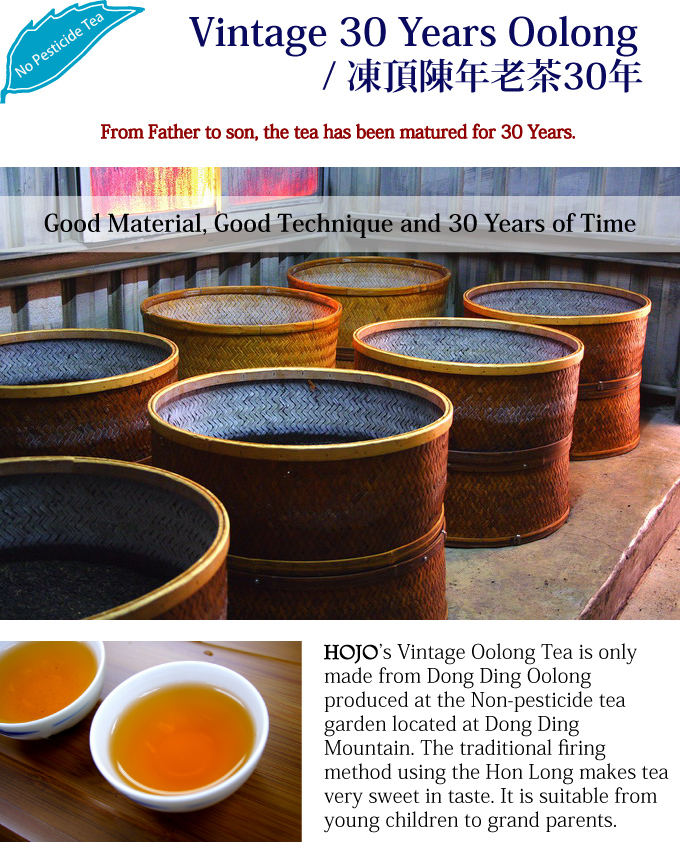
Many customers wonder what its taste like. It is one of the teas that customer always wanted to try. If we could explain its character, we will choose the Vintage Brandy as an example. The liquor of this tea is a deep orange in color. The flavor emitting from the tea making us assume that it has a bitter or astringent taste. However the moment you drink it, you have to admit that it is not so and you were quite mistaken in your assumption. It gives a very light and sweet flavor like dried fruit that spread over your mouth at once. This tea is very suitable to drink after eating oily food such as curry or meat.
The tea leaves are very well matured over the past 30 years and the substances in tea leaves are fully oxidized. Therefore you can keep the brewed tea for a few hours. Surprisingly the taste of tea does not change. It is also suitable to bring it to the office and drink it throughout the day as its taste is very stable.
This tea is suitable for any generation ranging from young children to old people. It gives no bitterness and astringency at all. This tea is also loved by ladies. In particular, they love its dried Longan-like flavor.
HOJO's Vintage Oolong is made from the genuine Dong Ding Oolong produced from the non-pesticide tea garden. It is not only rare, but also safe to consume.
Usually oolong tea is processed into a round shape. However, 30 years ago the bag rolling machine was not available in Taiwan. Therefore HOJO's Vintage Oolong is in loose tea leaf form. It indicates that the manual process was involved and there is no doubt that our tea was produced in 30 years ago.
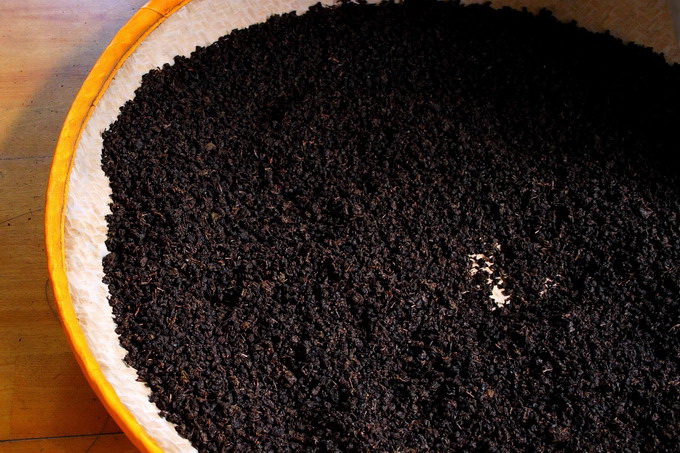
You may feel this tea is expensive. But what if you can brew for 7 times or more?

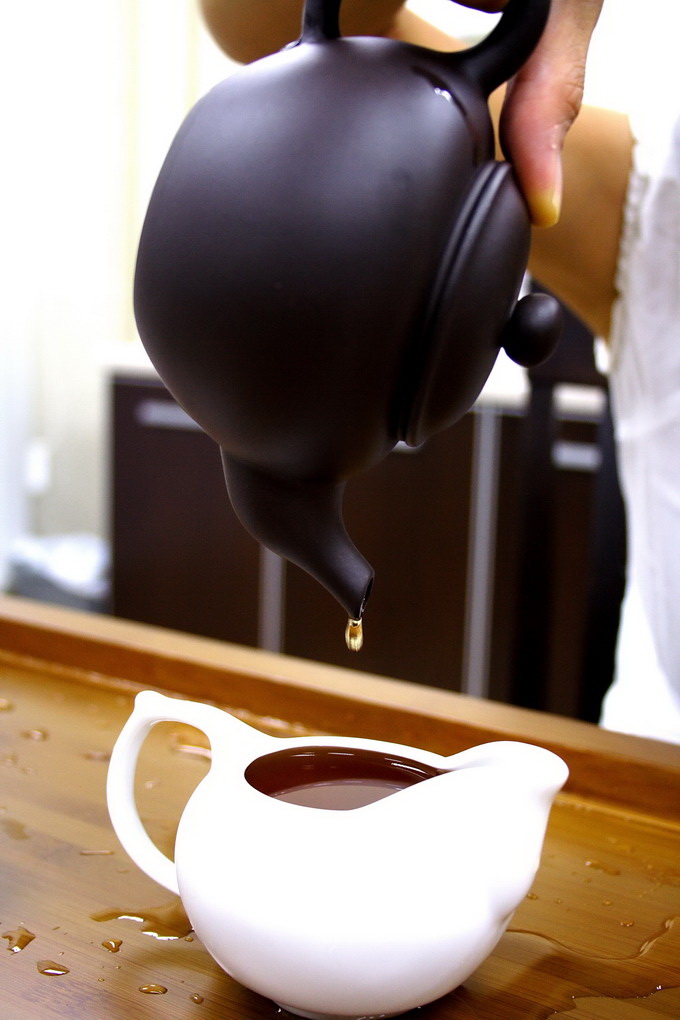
This tea is a very exclusive tea even in Taiwan. It takes 30 years to get vintage quality which is even rare to find in Taiwan. 30 years of storage makes tea extraordinarily smooth, and it is suitable for any generation in a family.
In order to produce premium vintage tea, it is not only 30 years of time that is important, but also the material used. Selecting the good material that contains fresh juice, tea could withstand the long storage.
Tea leaf is checked at regular intervals and dried if it shows excessive moisture content in order to protect the tea leaf from mold infection and quality deterioration. The drying method is one of the important factors that influence its quality.
When you drink this tea, you feel a dried fruity flavor. 30 years of maturation makes taste extremely smooth just like vintage brandy.
The HOJO's Vintage Oolong is only made by veteran tea master who devoted his life for baking this tea. He selected the most suitable charcoal which produces good fire without unpleasant flavor. With good charcoal, it gives a very refreshing drinking feeling which is Elegant, yet Very Easy to drink.
It was a tradition in Taiwan to keep good oolong tea in a pot and preserves it for many years. Since it takes unimaginably long time and extensive care to produce this tea, it is a very rare tea even in Taiwan and one could hardly obtain the high end quality.
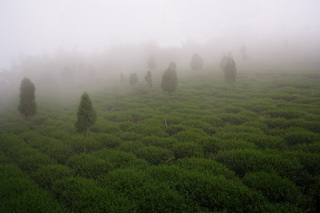
For HOJO's Vintage Dong Ding Oolong, the original tea leaf was produced 30 years ago from the Dong Ding Mountain area. Unfortunately, this oolong tea, produced at Dong Ding Mountain is getting very rare nowadays on account to its increasing demand and reputation. Many tea cultivators try to produce it at a lower cost and in larger volume which is more than that produced at the tea garden at Dong Ding Mountain. It is rather difficult to find genuine Dong Ding Oolong that is from Dong Ding Mountain. In Taiwan, people also start recognizing that Dong Ding Oolong = Type of Tea.
However HOJO only introduce the genuine Dong Ding Oolong. Dong Ding Mountain is not only famous for its name, but also its environment and weather is suitable for high grade tea. The altitude of this mountain is not that high which is at around 1000m plus. The secret of Dong Ding Mountain is that it always produces identical quality due to its weather and soil condition. The tea garden gets very strong sunshine in the morning, but it is completely covered by fog in the afternoon. In addition, the environment is very windy, and the soil condition is less rich in nutrition. This severe environment causes the tea leaves to accumulate a lot of substances and leaving it no chance to consume these substances. That's the reason tea why tea produced at Dong Ding Mountain gives a very strong flavor and sweet after taste.
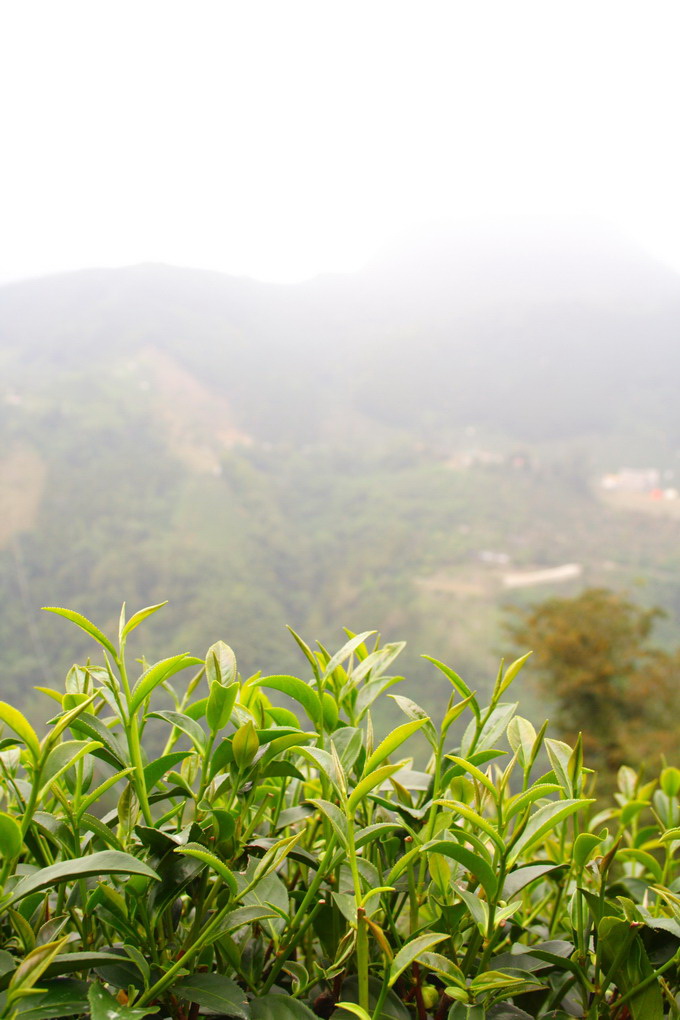
HOJO's Vintage Dong Ding Oolong is produced from Qing Xin Oolong Cultivar. The tea produced from this cultivar gives refreshing and delicate taste. Tea leaf is from the organic tea garden. As compare to the garden practice pesticide application, the production quantity in organic tea garden drops drastically. Tea leaf was plucked 30 years back in 1976. Plucking of tea leaf was conducted fully by hands. Usually one twig that consists of 3-4 leaves are selected.
After plucking, tea leaves are spread over the ground under the natural sunshine. It is called Sunshine Withering. Usually clouded weather is ideal to grow this tea in order to avoid excess damage on tea leaves. If the sunny weather continues, a black cloth is used to cover the tea leaves to block out the harsh rays of sunshine. With sunshine withering, moisture inside the tea leaf gets evaporated and fermentation is moderately triggered. The tea leaf will gradually start releasing a refreshing aroma.
The method of fermentation for oolong tea is completely different from that of black tea. After the sunshine withering is completed, tea leaves are conveyed into the factory and spread over a sheet. If tea leaves are rich in moisture, they are spread into a thin layer in order to increase the evaporation process. The tea leaves are then tossed onto a bamboo tray. This agitation and tossing, causes friction which in turn causes the tea leaves to start fermentation. The tray is then placed on a rack and these processes are repeated over and over again. This is what is called fermentation. Tea leaves gets oxidation mediated by the oxidation enzyme when the tea leaves get bruised.
Once entering the fermentation room, you might get surprised with its fragrance. You feel as if you are in a flower garden. Subsequently tea leaves are rotated in a bamboo drum. The tea leaves are lifted and dropped several times. Gradually the edge of tea leaves get damaged and further fermentation takes place. Tea leaves are again spread over the bamboo tray and the same process is repeated over and over again.
Once tea leaves get sufficient fermentation, it starts generating a flowery fragrance. Tea that is processed by a fine tea master is easily distinguishable. The original shape is maintained without any damage done to the tea leaves and only the edge of tea leaves are found to be red in color. This indicates that the tea leaves were successfully semi-fermented and the quality is far different from the tea leaves which have a reddish appearance at the center part of the leaf. Once the tea master finds that fermentation is sufficiently achieved, the tea is then sent for heat treatment in order to arrest further fermentation process. If this is not carried out swiftly, the tea leaves will keep on fermenting and it will finally turn into black tea.
The number of rotation and timing of fermentation is judged based on the moisture content, flavor and color. This decision requires top-notch experienced tea technicians which affects the quality of tea tremendously. All technicians follow the instruction of a tea master. In order to get good quality tea, we need to pick out an excellent tea master.
At this stage, tea is fermented and giving an identical character of Dong Ding Oolong. However tea leave has not been damaged or bruised except for its edge. Without physical damage on tea leaf, it is difficult to "brew". On the other hand, conducting the rolling process as black tea that tea leaf is twisted tautly under the strong pressure, tea leaf will be over damaged and get astringent and harsh in taste. In addition, excessive damage of leaf will expose constituent to the oxygen and cause unwanted oxidation that will also affect to the taste and flavor. Therefore the very unique rolling process called "Bag rolling" is used for oolong tea. Literary tea leaf is wrapped in cloth and rolled. Therefore, tea leaves are twisted just right with the right amount of pressure applied.
While the tea leaves are still warm and soft, it is quickly wrapped in cloth bag. About 10-20kg of tea leaf is wrapped and it is made into the size of about a basket ball. Then the end of cloth is mechanically twisted by machine in order to squeeze it into a very solid ball. Finally it becomes as solid as a stone ball and as a result the tea leaves are compressed very tightly.
Then, the cloth ball is clamped between disks at the top and bottom. The top disk does not move while the bottom disk rotate and tea gets further pressure through the motion. After the rolling process is conducted for a while, the bag is opened and the tea leaves are taken out and reheated again in a rotating drum. This is necessary as once the tea leaves cool down, it becomes crispy and easily crushed. This series of processes are repeated several times until it is well rolled.
The tea leaves are gradually tighten and become round in shape. High grade tea is usually very solid and it appears to be dark and shiny as the juice of the tea leaf is squeezed and hardens on the surface of the leaf.
The same sequence is repeated over and over again. The parameter is varied depending on the condition of leaf such as moisture content. It is important to feel the condition of tea leaf and apply the suitable method of process which is judge expertly by the tea master.
After this rolling process is completed, the tea leaves are dried and this will reduce the moisture content down to 5%.
Likely to the vintage brandy, this vintage tea shows similar characteristics. When keeping the high quality oolong tea for long time, tea is naturally matured and taste become very sweet and you would enjoy a dried fruity flavor. Traditionally, tea is stored inside a pot. But the detail of this method is varying depends on the factory. Most importantly, the moisture content of tea leaf must be checked at regular intervals and drying of tea leaf has to be carried out once the moisture content of tea leaf increased up to certain level.
At last vintage oolong is "wakening up". Using a made from bamboo called Hong Long (烘籠), tea is gently baked by the charcoal fire. According to the vintage tea master, the selection of the charcoal is a very important factor as the fire made from good quality charcoal does not generate unpleasant flavor. When we visited the factory, old tea master who is about 60-70 years old was quietly, yet effectively working there. The Hong Long room was extremely warm like sauna. But surprisingly we felt no smoky smell at all. Using the good charcoal and saturated fire, tea leaves will be well baked and flavor that was "sleeping" inside the tea leaves for the past 30 years will be literally "awaken".
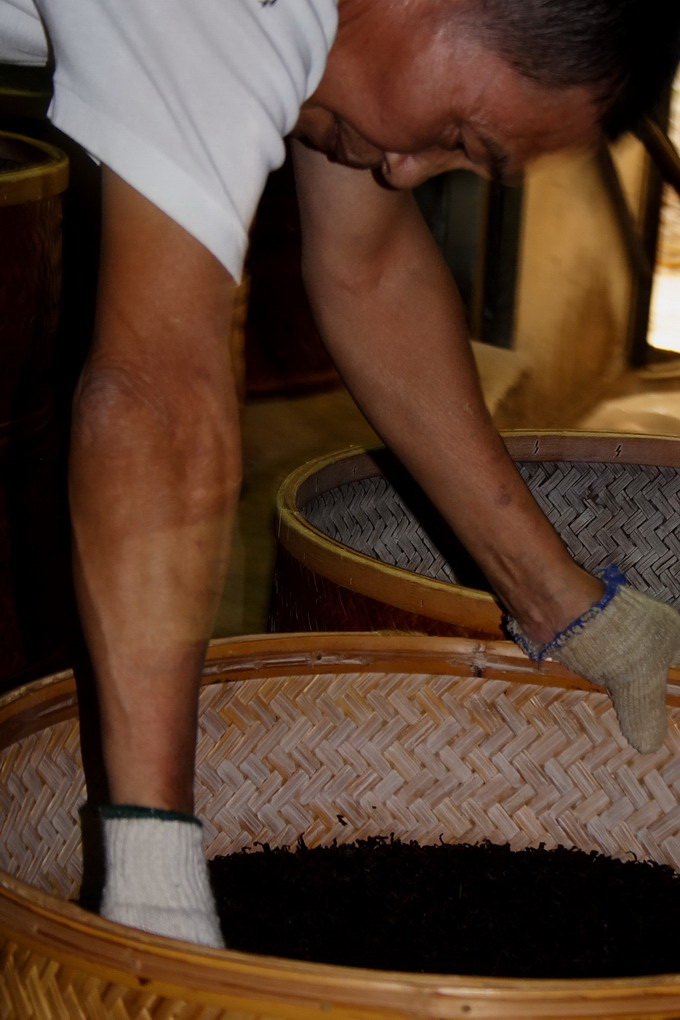
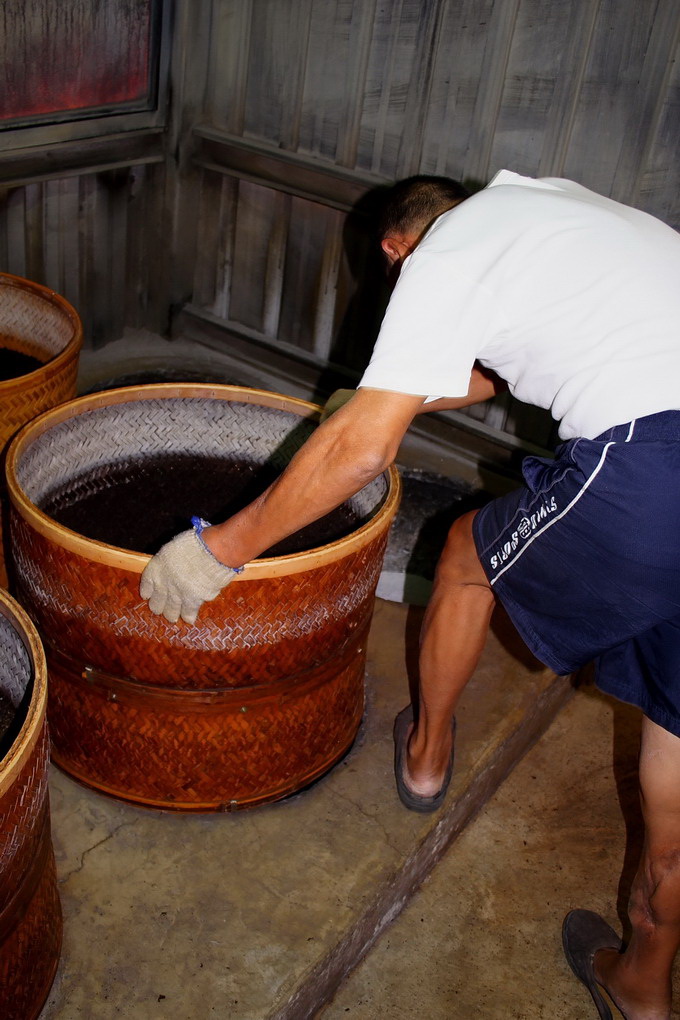

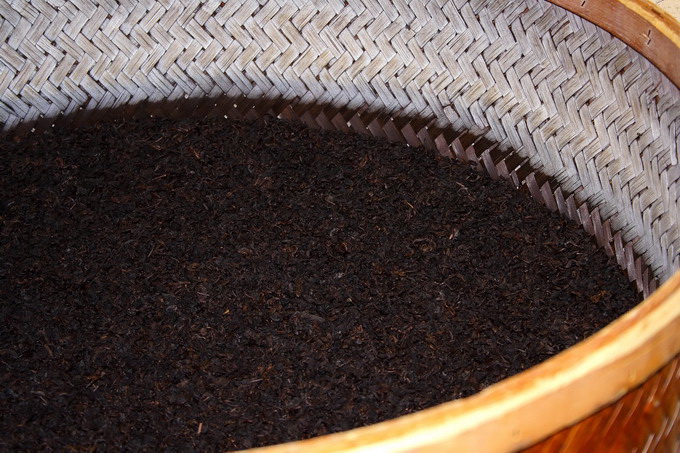
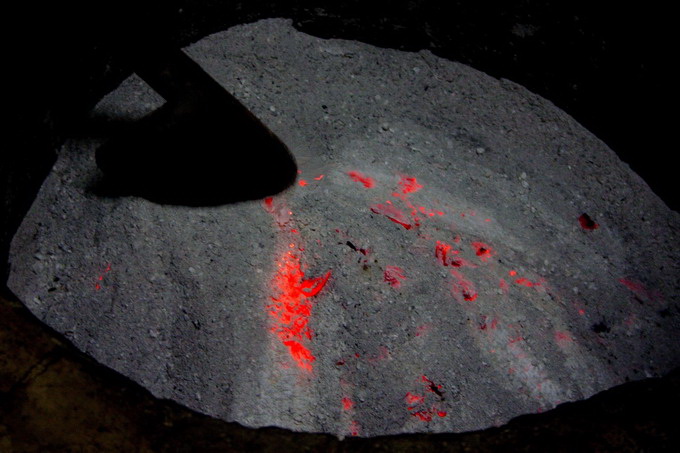
Tea leaves should not be as round in shape as ordinary oolong tea. It is because there was not bag rolling machine back in 30 years ago.
Tea leaves should be tight and not very fragile even it is pressed by finger. The surface of tea leaves is luster and each leaf must be in consistent size. Another way to judge the quality is to put the tea leaves in our palm and shake them. The tea leaves are weighty if it is of good quality.
The size and shape of tea leaves must be consistent if it is a good grade. It indicates good material and tea was well made.
Tea leaves do not contain unnecessary object such as fiber, piece of bamboo, wood, stone or sands.
There is a fruity flavor when this tea is brewed. The flavor lasts even tea is brewed for several times.
Bright and transparent reddish brown color.
Refreshing, no astringency and sweet after taste.
Tea leaf is maintaining its original shape of tea leaf and containing less cracked leaf.
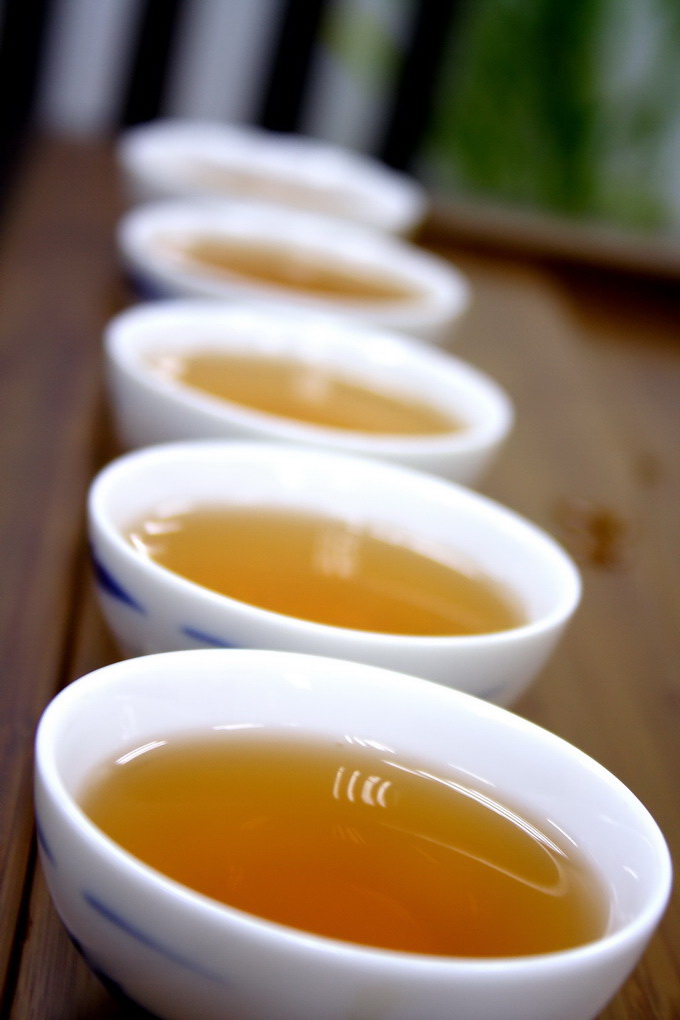

Go to further information about suitable water for brewing tea >>
Vintage oolong tea does not contain much tannin and poly phenol due to the long period of maturation. This tea is suitable for a wide range of people ranging from young children to old people. Thanks to its refreshing taste, this tea is suitable to be served after meal; its refreshing taste washes away the oil remained and enhances the taste of food.
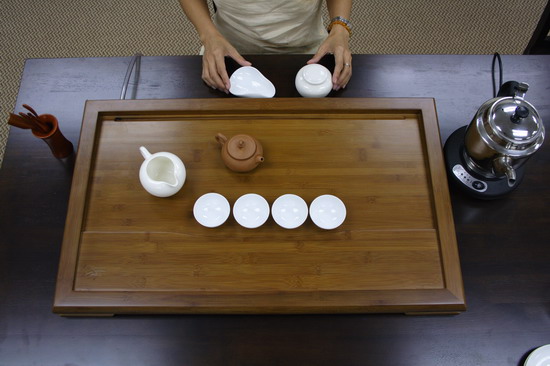
Arrange tea ware.
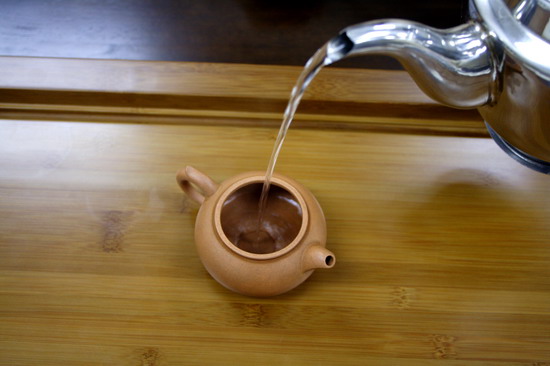
Pour boiling water into the tea pot and fill up to 70%. This is to heat up the tea pot.
Go to further information about suitable water for brewing tea >>
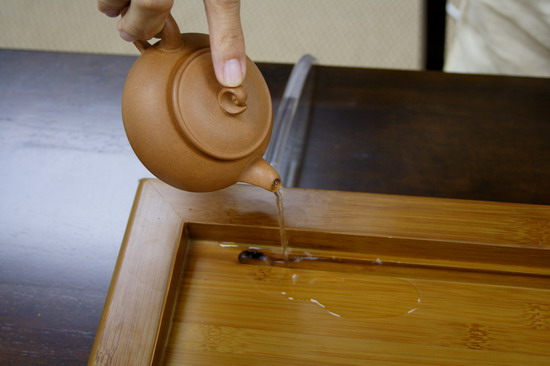
After 20 seconds, remove hot water from the warmed tea pot.

Usually 1g is equivalent to 25〜50ml of water. For the small tea pot for 1 to 2 persons, 3-4g is sufficient.
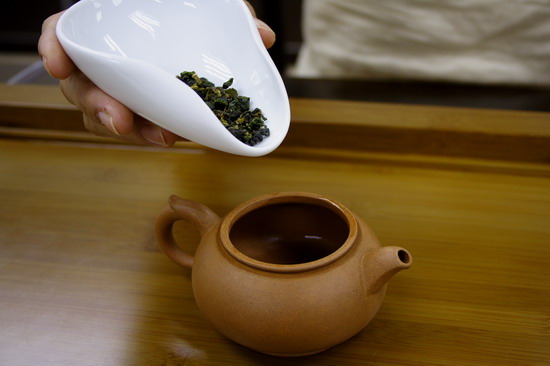
The tea pot in the photo is about 200ml and therefore we take tea leaf around 5g.

Pour boiling water onto tea leaf up to 50% of the volume of tea pot. It is not for washing purpose, but to heat up the tea leaf and open them up.
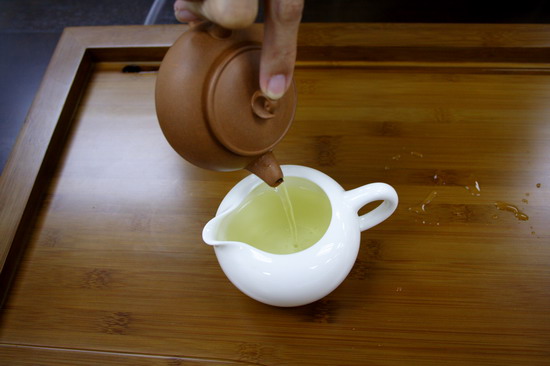
Once again pours off hot water within 10 seconds. Usually we recommend 7 seconds.
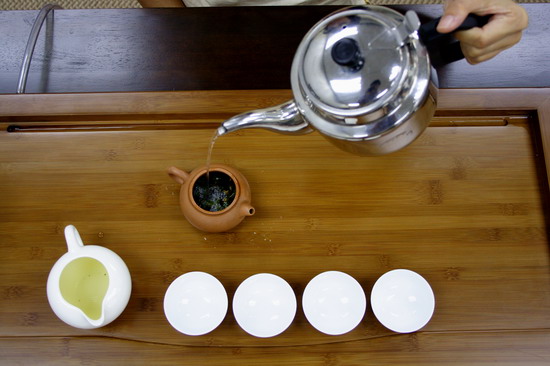
Pour boiling water into tea pot up to 90%.
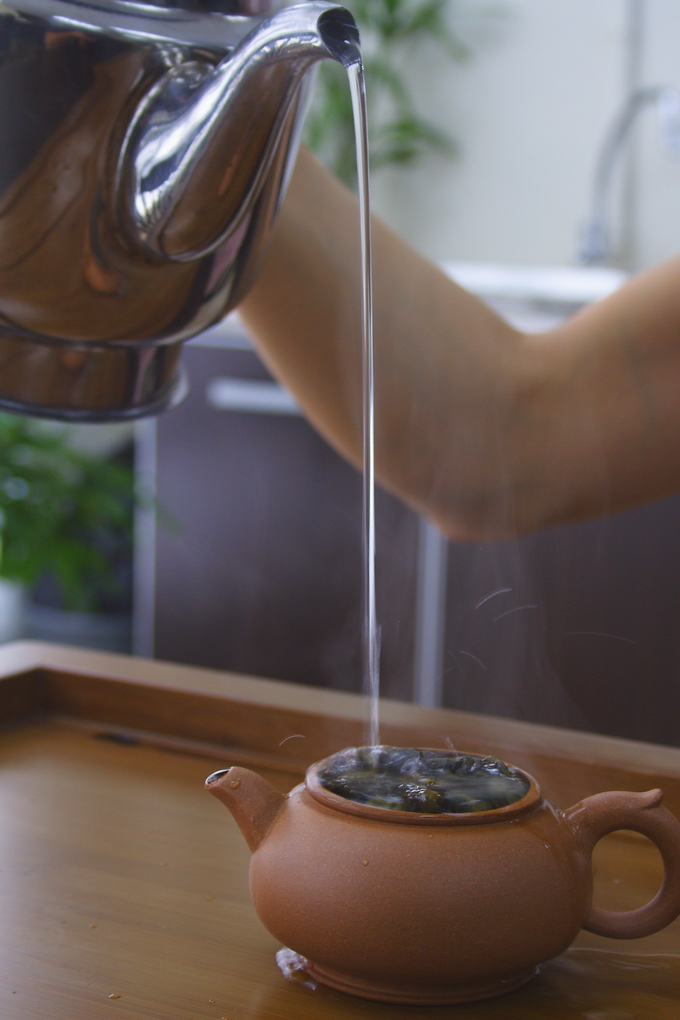
You can feel the aroma through the upcoming steam.
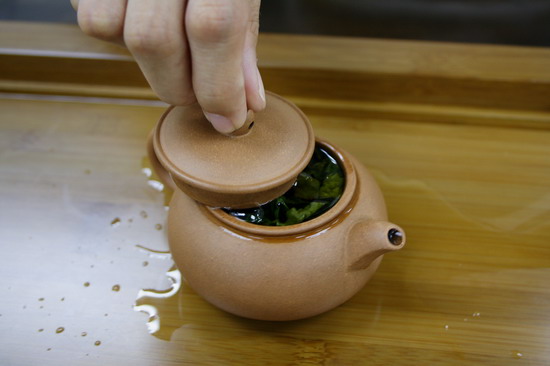
Gently place the lid and leave it for 55 seconds. For second brewing leave it for 45 seconds, follow by 55 seconds for the third brewing.
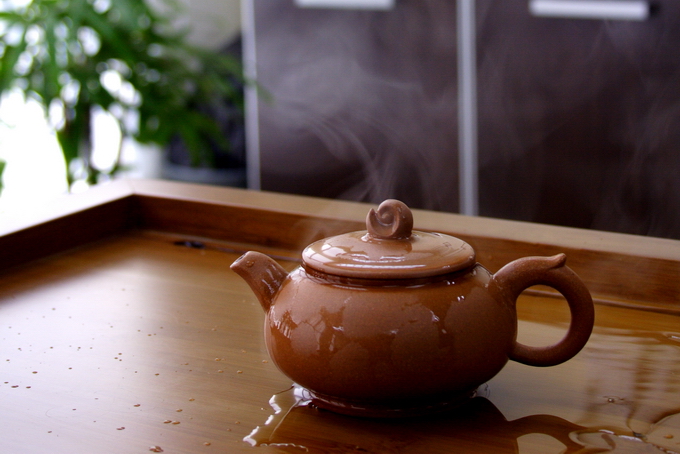
In China, they pour boiling water over the cap in order to keep the tea pot warm. But this method never used in Taiwan as they think tea pot is hot enough.

While waiting for brewing, pour hot water from pitcher into the tea cups in order to warm them up. But this is not practiced in Taiwan as they believe there is no need to warm up the tea cup.
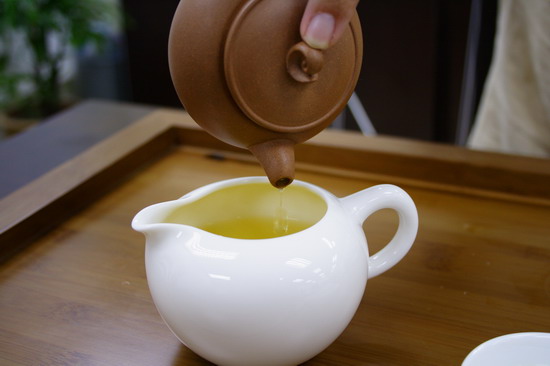
Pour tea into pitcher completely. It is important to enjoy the following brewing.
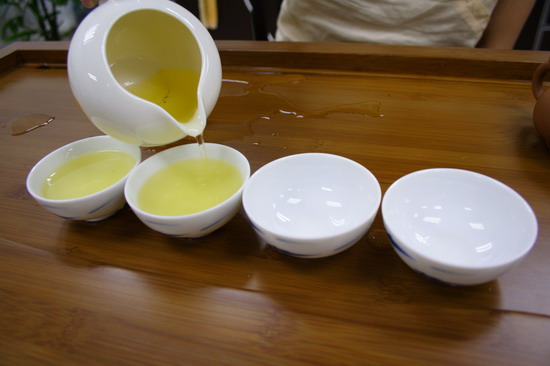
Pour tea from the right end which is supposed to be served for the guest.

The last one is meant for the host.
Some people worry about the brewing method which is too traditional and complicated. However once you understand the theory, it is not so difficult. Most importantly, use very hot water and never reduce its temperature. The taste of green tea comes from the substance called theanine which is a kind of amino acid. This is the major component of sweet taste in green tea. As theanine is easy to be extracted at low temperature, brewing temperature for green tea is very low, while the taste of oolong tea is poly phenol which required very high temperature to be extracted.
Once a bag of tea is opened, please finish it within 6-9 months if you wish to enjoy its freshness. From the medical point of view, it is safe to consume the tea even if it is kept for a few years. However the freshness disappears if it is kept for too long. Tea must be tightly sealed before it is kept. Tea should be kept in ambient and dry conditions such as in the living room, but it must be completely away from humidity. Tea should not be kept in the kitchen as the environment is very humid. Avoid enclosed area such as inside the cupboard or drawer as these places are damp. Also avoid opening the bag of tea in humid atmosphere. It is recommended to open the bag during a sunny day or under air-conditioned atmosphere. Once tea leaves absorb moisture, deterioration of tea will be triggered within a few days. Tea will then give an astringent taste, sometime it tastes sour. The fresh aroma also becomes weaker.
The quality of tea lasts longer if it is kept in the fridge. However we strongly recommend you not to keep tea in the fridge. When tea is withdrawn from the fridge, there is usually condensation. Once tea is exposed to moisture during condensation, the quality will deteriorate within a few days. The higher moisture content in the tea leaves will trigger oxidation and it will completely destroy the quality of tea.
Here’s one frequently asked question: what happens if bag is sealed using tape or tea is packed in zipper bag and kept inside the fridge?
For your information, these simple sealing methods are not sufficient. When the bag is withdrawn from the fridge, it is cold inside the bag and therefore causes negative pressure. Air will be drawn from outside and condensation will occur. In addition, if the bag is taken in and out from the fridge very often, this will cause heat stress to the tea leaves as temperature is increased and decreased very frequently. If tea is kept in the fridge, when it is withdrawn from the fridge, it is necessary to leave it in ambient atmosphere for more than 24 hours in order to warm up the tea leaves. Based on our experience, 12 hours is not long enough. We may think tea is warmed up, but inside the bag, the tea leaves are still cold due to insulation effect.

 |
We accept various kinds of credit card through Paypal.
Only if customer prefer other option of payment, we suggest "Bank Transfer".
Various choice of shipping method
EMS, SAL, Small Packet, Small Packet (SAL) Yamato Express and Surface
For shipping tea, we usually suggest small air parcel, the estimated shipping cost of tea in 100g (with wrapping material ) is
Small Parcel
USA JPY 600, EU JPY600 and Asia JPY470
Small Packet (SAL)
USA JPY380, EU JPY380 and Asia JPY320
The shipping fee to oversea by small air parcel happens to be even cheaper than domestic shipping fee in Japan.
For your information, some countries, EU in particular imposes custom duty. We need buyer to bare the duty. We are sorry, but we cannot change the amount on the invoice, and we do not mark any packages as gifts. We will strictly follow the custom regulation.